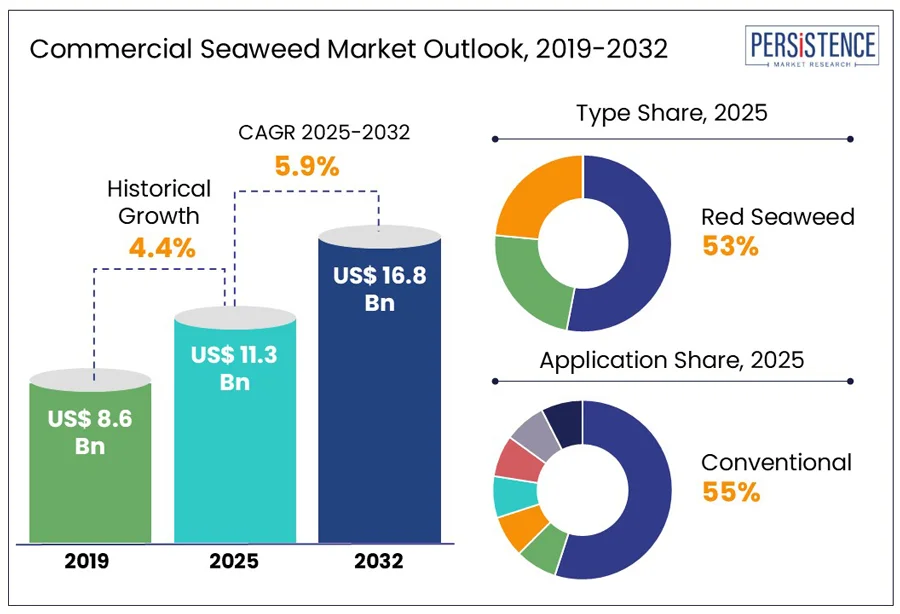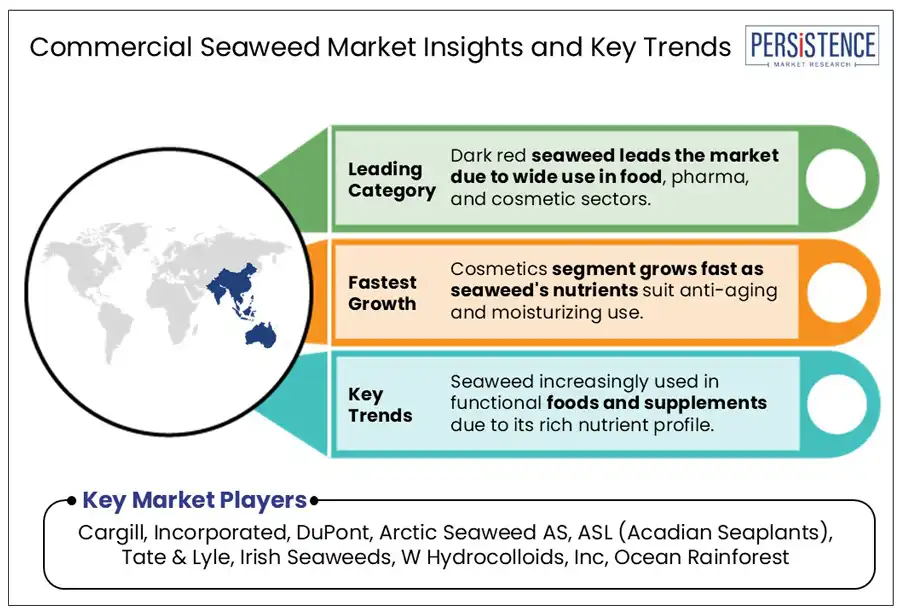ID: PMRREP14698| 195 Pages | 5 Jun 2025 | Format: PDF, Excel, PPT* | Food and Beverages

The global commercial seaweed market size is estimated to grow from US$ 11.3 billion in 2025 to US$ 16.8 billion by 2032. The market is projected to record a CAGR of 5.9% during the forecast period from 2025 to 2032. According to the Persistence Market Research report, the global industry is poised for steady long-term growth, driven by rising demand for sustainable food, biofertilizers, and cosmetic ingredients. Innovation in aquaculture, growing government support, and alignment with climate goals are accelerating adoption.

Key Industry Highlights:
|
Global Market Attribute |
Key Insights |
|
Global Commercial Seaweed Market Size (2025E) |
US$ 11.3 Bn |
|
Market Value Forecast (2032F) |
US$ 16.8 Bn |
|
Projected Growth (CAGR 2025 to 2032) |
4.4% |
|
Historical Market Growth (CAGR 2019 to 2024) |
5.9% |
The convergence of sustainability and nutrition is a major driver boosting demand in the commercial seaweed market. Consumers increasingly seek nutrient-dense, plant-based foods that support health without harming the environment. Seaweed perfectly meets this need, offering essential vitamins, minerals, and bioactive compounds while enabling low-impact farming that helps reduce carbon emissions and ocean acidification. The Food and Agriculture Organization (FAO) estimates that seaweed cultivation could absorb up to 135 million tonnes of CO2 annually by 2050, underscoring its significant climate mitigation potential. This unique combination of environmental benefits and nutritional value aligns with global sustainability goals and public health priorities. Consequently, seaweed is evolving from a niche product into a vital resource for sustainable nutrition, attracting growing investment and interest from governments and industries worldwide.
Environmental challenges pose significant threats to seaweed growth and productivity, creating a key restraint for the commercial seaweed market. Factors such as rising ocean temperatures, pollution, and acidification disrupt marine ecosystems, leading to reduced seaweed yields and lower quality biomass. Contaminants from industrial runoff and plastic waste further degrade cultivation sites, increasing the risk of disease and mortality in seaweed farms. These conditions hamper sustainable production and strain the supply chain, causing a widening demand-supply gap as global appetite for seaweed-based products grows.
The commercial seaweed market offers key players a valuable opportunity to develop high-value biofertilizers and biostimulants that promote sustainable agriculture by enhancing plant growth, improving stress resilience, and increasing nutrient efficiency. Seaweed-based products are rich in bioactive compounds such as polysaccharides, amino acids, and natural growth hormones, which help boost crop yield while reducing reliance on synthetic chemicals. This is aligned with the rising global demand for eco-friendly farming practices and supports soil health and biodiversity. For example, In April 2025, Bayer launched its first high-activity seaweed biostimulant product, An Hai Long. As the agriculture sector increasingly adopts sustainable inputs, seaweed-derived biofertilizers and biostimulants stand to play a pivotal role in driving growth.
Red seaweed holds approximately 53% share, making it the dominant segment due to its extensive industrial applications. Its high content of hydrocolloids, especially carrageenan and agar, makes it invaluable in the food industry as a natural thickening, gelling, and stabilizing agent used in dairy products, meats, and plant-based alternatives. In the pharmaceutical sector, red seaweed-derived compounds exhibit antiviral, anticoagulant, and anti-inflammatory properties, supporting their use in wound care, drug delivery systems, and nutraceuticals. Additionally, red seaweed extracts are increasingly integrated into cosmetic and personal care formulations for their moisturizing and skin-soothing benefits. Its adaptability to various processing techniques and relatively higher yield compared to other species enhances its commercial appeal. As demand grows for clean-label and functional ingredients, red seaweed’s unique properties continue to fuel its dominance in the global seaweed market.
Cosmetics and personal care is expected to grow at a 7.6% CAGR during the forecast period 2025 to 2032, driven by rising consumer demand for natural, sustainable, and efficacious skincare solutions. Seaweed, rich in antioxidants, vitamins, and minerals, offers anti-aging, hydrating, and skin-rejuvenating properties, making it an ideal ingredient for modern beauty formulations. Its natural bioactivity aligns with the clean beauty movement, which emphasizes transparency, eco-friendly sourcing, and wellness-driven ingredients. Seaweed's versatility and sustainability appeal to both consumers and brands seeking effective, environmentally responsible products. For instance, Seaweed Bath Co. expanded its natural beauty portfolio by acquiring Andalou Naturals and Mineral Fusion, enhancing its presence in skincare and color cosmetics.

The North America is witnessing dynamic growth, fueled by rising environmental awareness, innovation in aquaculture, and revitalized traditional knowledge. In the U.S., seaweed farming has expanded rapidly, with dozens of farms operating in New England, the Pacific Northwest, and Alaska. Innovative vertical or 3D farming techniques enable high-yield production in compact marine spaces, improving efficiency and sustainability. NOAA's collaboration with local stakeholders further strengthens the sector by providing research and policy support. In Canada, Indigenous communities have long used seaweed for food, medicine, and cultural purposes, and their practices are informing modern, ecologically responsible farming approaches. The Canadian seaweed industry is also gaining momentum, driven by its potential for carbon sequestration, biofiltration, and ecosystem restoration.
The Europe commercial seaweed market is witnessing steady growth, driven by rising demand for sustainable and alternative protein sources as well as products with high nutritional value. Coastal countries such as the U.K. and France are seeing increased consumption due to existing familiarity with seaweed, both as a traditional food and a culinary innovation. France’s Brittany region, for instance, has long embraced wild seaweed in local cuisine, with chefs incorporating varieties like dulse and nori into seafood dishes. Countries like Ireland, Denmark, and the U.K. are leading exporters, supported by local investments aimed at expanding seaweed farming for its diverse applications and job creation potential. The European food industry is increasingly recognizing seaweed as a unique flavor enhancer, integrating it into rice dishes, soups, crackers, pâté, and mustard, highlighting the growing mainstream acceptance of seaweed as a versatile food ingredient.
The Asia Pacific dominates the global industry, accounting for approximately 98% of global farmed seaweed production, with China, Indonesia, the Philippines, North and South Korea, Japan, and Malaysia leading cultivation. China alone contributes around 59% of global algal farming output, highlighting its central role in seaweed supply. Commercial seaweed farming began in Asia over five decades ago and has since evolved into a mature and rapidly expanding industry. While traditional leaders continue to scale production, emerging players like India are entering the sector with strong policy support. Under the Pradhan Mantri Matsya Sampada Yojana, India has allocated ?640 crore to boost seaweed cultivation and improve value chains. The initiative aims to reduce reliance on wild harvest, enhance coastal livelihoods, and meet domestic demand.
The global commercial seaweed market is fragmented in nature, composed largely of small to medium-scale producers, particularly across the Asia-Pacific region where traditional aquaculture practices prevail. As seaweed finds increasing application in food, cosmetics, pharmaceuticals, biofuels, and sustainable agriculture, competition is intensifying, encouraging innovation and global expansion. In response, larger players are beginning to consolidate their positions through strategic investments in integrated supply chains, enhancing quality control, traceability, and production scalability. Simultaneously, growing government support for seaweed cultivation reflects a recognition of its environmental and economic potential. The market is also benefiting from rising demand for plant-based, clean label ingredients, aligning with broader health and sustainability trends. However, geopolitical tensions such as the US–China tariff conflict could present supply chain and trade challenges, potentially hindering seamless growth in a market otherwise positioned for broad, long-term opportunity.
The global industry is projected to be valued at US$ 11.3 Bn in 2025.
Sustainability and nutrition converge to fuel demand for the commercial seaweed market.
The commercial seaweed market is poised to witness a CAGR of 5.9% between 2025 and 2032.
Creating high-value biofertilizers and biostimulants for sustainable agriculture is the key market opportunity.
Major players in the commercial seaweed market include Cargill, Incorporated, DuPont, Arctic Seaweed AS, ASL (Acadian Seaplants), Tate & Lyle, Irish Seaweeds, W Hydrocolloids, Inc., and others.
|
Report Attribute |
Details |
|
Historical Data/Actuals |
2019 - 2024 |
|
Forecast Period |
2025 - 2032 |
|
Market Analysis |
Value: US$ Bn, Volume: Tons |
|
Geographical Coverage |
|
|
Segmental Coverage |
|
|
Competitive Analysis |
|
|
Report Highlights |
|
|
Customization and Pricing |
Available upon request |
By Type
By Form
By Application
By Region
Delivery Timelines
For more information on this report and its delivery timelines please get in touch with our sales team.
About Author